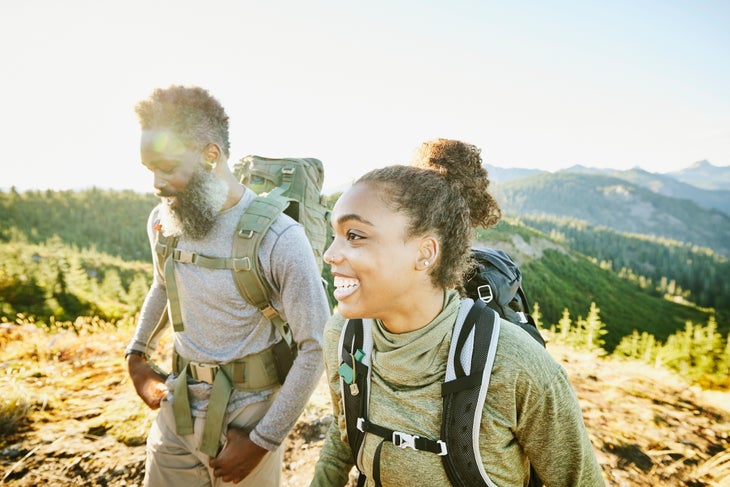Products You May Like
A few years ago, I had a reputation for being the fastest pair of legs on the trail. Put me in any given group, and I would invariably shoot to the front, leaving friends, partners, and basically everyone else in my dust. It was awesome—while it lasted.
Then, I stumbled into injury. Add to that several months of downtime, a long winter, and two bouts of breakthrough COVID-19 infections, and my fitness level isn’t what it once was. Now, I find myself lagging behind my boyfriend on even short hikes, and breathless with partners I once considered my equals.
It’s hard to be slow, but it’s even harder when you know what it feels like to be fast. For a long time, I was ashamed of my sluggishness. I felt like I’d failed—like I wasn’t good enough to take up a parking space at popular trailheads, or even to live in the outdoor epicenter of Boulder, Colorado. Could I still call myself a “hiker”? Or did my slowness make me a fraud?
Some hiking communities are laid-back and unconditionally welcoming. But in some places—like Boulder—hiking can feel like a competition. It doesn’t help that outdoor media is constantly pushing fast-and-light gear and celebrating fastest known times and speed records on everything from the Appalachian Trail to famous peaks. Pretty soon, it can feel like climbing a mountain is always about getting to the top. That hiking is about conquering.
You can internalize all these misconceptions if you want to. You can look at a half-climbed peak as a failure. You can cry on the steeps. Wince on the flats. Apologize for your pace, your fitness level, your existence. Believe me, I’ve tried it all. But there’s an easier path.
Start by taking a deep breath. Then, remind yourself why you love hiking. I didn’t get into this activity to beat the pants off college kids and families with strollers, and you probably didn’t either. So, why are you waking up early to hit the trail on a Saturday? Is it because you appreciate nature? Love the feel of wind on your face and the movement of your legs churning uphill? Lean into that.
Hiking isn’t a competition. (Most things in life aren’t.) There’s no “right way” to enjoy the outdoors, and no stats you need to hit to “earn” your place on the trail. You belong here, no matter how fast you’re going, what you weigh, or what your VO2 max is. The mountain doesn’t care what you look like. The trail doesn’t care how many steps you take. It knows the truth: You are perfect just as you are.
So, after that deep breath, lift your head up high. Smile. Own your body and your pace, shoulder your pack, and start walking.

How to Embrace Your Pace
Try these strategies to learn to love hiking at any speed.
- Be nice to yourself. Thoughts are dangerous things, and they can ruin your day if you let them. Next time you start mentally berating yourself for being slow or needing a rest, pause. Then, pivot from negative self-talk to neutral self-talk (or positive affirmations if it feels natural). Tell yourself your pace is just fine, you’re outside doing what you love, and that there’s no right way to hike. Then, take all the rest you need.
- Fake it ‘til you make it. Pretending to love your hiking style out loud can lead to big gains in believing it deep down. Instead of apologizing for your pace—which can drop you into an embarrassed or defensive mindset—simply thank your friends for waiting on you. If a colleague asks you how long a hike took you, or if you made it to the top, smile big and say, “I took my time and enjoyed the hell out of it. How was your weekend?”
- Set expectations. Nervous about a group hike? Reach out to your hiking partners the night before. Explain what you’re feeling and tell them you don’t expect to be breaking any records. Setting that expectation early (and, most likely, hearing assurances that your buds just want to spend time with you) can make a big difference.
- Give up the FOMO. One of the hardest things about huffing and puffing at the back of the group is the fear of missing out on all the conversations that might be happening near the front. Instead of kicking yourself for your natural pace (or killing yourself to keep up), embrace your own experience. Sure, the frontrunners may say something funny or see something unique. But so will you.
- Ask to set the pace. If playing sweep isn’t your idea of a good time, ask your partner to let you walk up front. This is the safest and most efficient way to keep a group together, and it’s one of the best cures for pace anxiety. Hiking first is also a great way to practice your navigational skills—and snag a front-row seat to the scenery.
- Bring a newbie. If you have a friend who’s interested in trying hiking, consider inviting them along on your upcoming group hike, especially if they’re close to your fitness level or chill enough to avoid pushing the pace. Mentoring someone can be a great confidence boost, and you’re guaranteed to have company.
- Be safe. There’s nothing wrong with hiking more slowly than your friends. But as with any outdoor endeavor, make sure you’re realistic about safety. Always be sure to check the weather and set a turn-around time before your hike. Turn back at the first sight of a gathering storm, even if you haven’t reached your goal destination. Finally, if you’re hiking with others and expect to split up, make sure both groups have navigation gear, a good sense of the route, and walkie talkies or other means of staying in touch.
